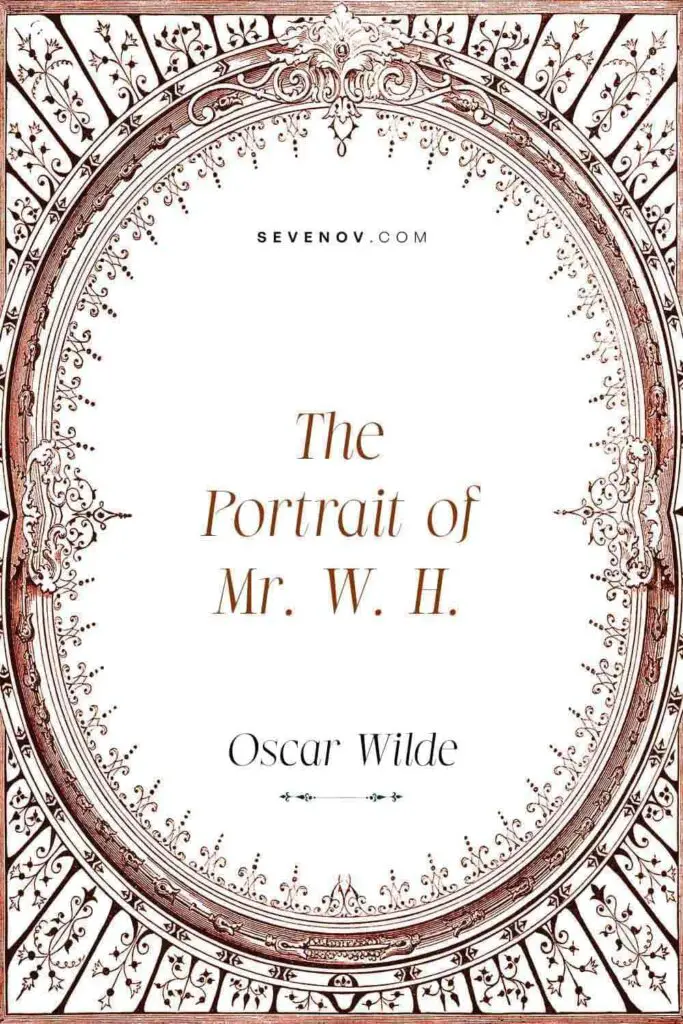
The Portrait of Mr. W. H. by Oscar Wilde
Author: Oscar Wilde
Published: 1889
Genre: Short Story
“The Portrait of Mr. W. H.” is a literary enigma wrapped in the world of Shakespearean intrigue. This lesser-known work by Oscar Wilde has sparked curiosity and debate among scholars and enthusiasts alike. With its mysterious narrative and connection to the great bard himself, this novella invites readers into a web of speculation and fascination. The short story that first appeared in Blackwood’s Magazine in 1889, then anthologized in his collection Lord Arthur Savile’s Crime and Other Stories in 1891. In this blog post, we’ll delve deep into the heart of “The Portrait of Mr. W. H,” exploring its synopsis, characters, themes, and the enduring mysteries it presents.
1. The Portrait of Mr. W. H. Synopsis
“The Portrait of Mr. W. H” explores the narrator’s evolving beliefs in a theory regarding Shakespeare’s Sonnets, initially advocated by their friend Cyril Graham. The theory suggests that a young actor named Willie Hughes was the subject of the Sonnets. The narrator starts as a skeptic, but after writing a passionate letter supporting the theory, he has a change of heart. When discussing it with their friend Erskine, who remains steadfast in his belief in the theory, the narrator experiences doubt again. The story raises questions about belief, passion, and the pursuit of literary theories, leaving the authenticity of the theory unresolved in the end.
2. The Portrait of Mr. W. H. Summary
“The Portrait of Mr. W. H.” explores themes of obsession, art, and the enigmatic nature of Shakespeare’s sonnets. It is a tale of the relentless pursuit of truth and the price one pays for unearthing secrets. The novella raises questions about the identity of Shakespeare’s muse and the lengths to which one is willing to go in the pursuit of knowledge.
Chapter 1
The narrator, dining with his friend Erskine, discusses literary forgeries, including Macpherson, Ireland, and Chatterton. They debate the ethical and aesthetic aspects of artistic forgeries. Erskine shares a personal story about his late friend, Cyril Graham, who had a theory about Shakespeare’s Sonnets. According to Cyril, Mr. W. H., to whom the Sonnets are dedicated, was a real person, a young actor named Willie Hughes. Cyril discovered an authentic portrait of Willie Hughes, confirming his theory. The narrator expresses skepticism but ultimately believes in the authenticity of Cyril’s findings.
Cyril Graham dies by suicide after being accused of forging evidence to support his theory. The narrator believes in Cyril’s theory and wants to prove it. However, Erskine disagrees with the theory and warns against pursuing it. Despite Erskine’s skepticism, the narrator is determined to carry on Cyril’s work and reveal the truth about Willie Hughes. The chapter ends with the narrator’s emotional reflection on Cyril Graham as dawn breaks over London.
Chapter 2
The narrator awakens and spends time analyzing Shakespeare’s Sonnets, particularly those addressed to a mysterious figure named Willie Hughes. They explore the idea that Hughes might have been a young actor who played roles in Shakespeare’s plays. The narrator delves into the Sonnets, dissecting the imagery and themes related to Hughes, including his beauty and theatrical talent. The chapter also speculates about Hughes’ later life and contributions to the theater, ultimately concluding that his true monument is the enduring impact of Shakespeare’s drama.
Chapter 3
The narrator, enthusiastic about Cyril Graham’s theory connecting Shakespeare’s Sonnets to a fictional actor named Willie Hughes, writes a passionate letter to a friend, Erskine, in support of the theory. However, after sending the letter, the narrator experiences a sudden loss of belief in the theory. The narrator meets with Erskine, who remains convinced of the theory’s validity. Despite the narrator’s efforts to persuade him otherwise, Erskine decides to dedicate his life to proving the theory and eventually takes his own life. Later, the narrator learns that Erskine actually died from consumption, not suicide.
Lady Erskine gives the narrator a painting of Willie Hughes as a memento. The story ends with the narrator keeping the picture, still unsure about the theory’s validity.
3. Characters
Cyril Graham – A passionate Shakespearean scholar who becomes obsessed with proving the existence of the portrait of Willie Hughes.
Erskine – Graham’s friend who receives Graham’s letter and delves into the mystery after his death.
Willie Hughes – The mysterious young man believed to be the “Fair Youth” of Shakespeare’s sonnets.
Shakespeare – The legendary playwright and poet, whose sonnets and identity are central to the novella.
4. Themes
Obsession – Graham’s relentless pursuit of the portrait and his theory on Shakespeare’s sonnets highlight the theme of obsession and its destructive consequences.
Art and Identity – The novella explores the relationship between art and identity, particularly in the context of Shakespeare’s works and the mystery surrounding his sonnets.
Legacy and Literature – “The Portrait of Mr. W. H.” delves into the idea of literary legacy and the enduring impact of great works of literature.
5. Conclusion
“The Portrait of Mr. W. H.” remains a captivating literary mystery, reflecting Oscar Wilde’s fascination with Shakespeare and the complexities of art and identity. As readers, we are left with questions about the true identity of Willie Hughes and the existence of the elusive portrait. This novella invites us to contemplate the lengths to which individuals will go in their pursuit of truth and how obsession can shape their lives. Wilde’s work continues to intrigue and inspire those who seek to unravel the mysteries within Shakespeare’s sonnets and the enigmatic figure of Willie Hughes.




